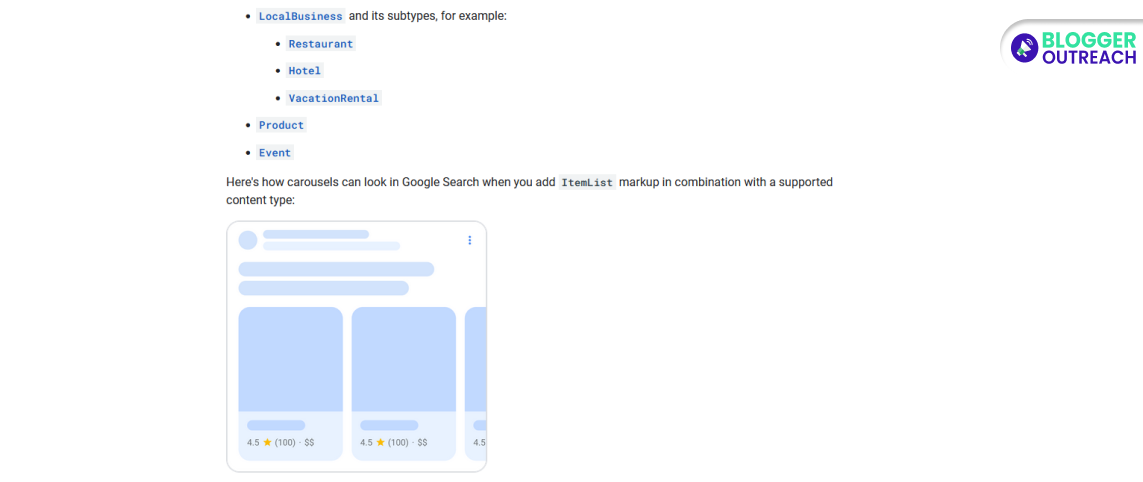Table Of Content
Google’s new structured data carousel is a game-changer for website owners and digital marketers. But how?
Let’s explore Google’s update and its impact on businesses in the digital marketplace.
Understanding Structured Data Carousels
Fastly, what is a structured data carousel?
Google’s new structured data carousel displays a horizontally scrollable list of rich results like the ‘People Also Ask’ or image preview carousels. Also, it highlights entities from one website, called a ‘host carousel’.

Google Has Said:
“Google uses structured data to understand the content on the page and show that content in a richer appearance in search results, which is called a rich result. This guide focuses on a new carousel-rich result that’s in beta, which is a list-like rich result that people can scroll horizontally to see more entities from a given site (also known as a host carousel). Each tile in the carousel may have information from your site about the price, rating, and images for entities on the page.”
Google sees a website’s owner as someone who can add structured data for their online presence. They want specific structured data like ItemList, LocalBusiness, Product, or Event types to make the content enriching and relevant to the website’s offerings.
Hence, the new carousel can make a big impact.
For example: a user looks for a hotel, and Google shows a carousel with prices, ratings, and images from the hotel’s site. This setup could draw the user to click directly in a visually appealing way.
Where We’re Going—The Possibilities Are Rich
Structured data carousels change how search results are seen. Basically. They are not about ranking only; they are about standing out in a captivating way.
In fact, they offer various benefits, like boosting local businesses and their branches’ visibility.
Also, they showcase products or events digitally.
Furthermore, Google’s carousel helps websites is making the search results fairer.
(by promoting structured and relevant information)
So, websites need to give the correct data in the right way for this to work well.
Let’s Understand In Real-World Terms
Implementing structured data carousels is an exercise in precision. Website owners must be careful in their use of structured data to ensure that they stay in Google’s good graces.
In fact, more importantly, in the new carousel’s rotation.
Here Is A Brief On The Actionable Steps:
- First, Identify Eligibility — Check if the website’s content falls under the categories for which the carousel is intended.
- Second, Structured Data Markup — Integrate appropriate ItemList structured data with specificity.
- Third, Quality and Accuracy — The structured data content must be high quality and accurate, detailing precise information that can make or break user trust and interest.
- Fourth, Ongoing Maintenance — The digital landscape is dynamic. The carousel inclusion is not a set-it-and-forget-it deal. Websites must keep structured data up to date.
- Finally, Monitoring And Adjusting — Keep an eye on search performance reports and make changes as the strategy adapts to search behaviour shifts.
The Road To Enriched Results—Your Next Steps
So, it’s clear that structured data carousels are set to become a pivotal feature. But how can brands capitalize on this evolution?
(i) Crafting A Comprehensive Structured Data Strategy
Companies should update how they organize their data to fit the new carousel feature. This means updating old structures or making new ones.
So, the plan should cover everything the carousels involve, including various industries and website aims.
(ii) Educate And Empower Team Members
Structured data is important for everyone. Marketers, developers, and content creators all play a part. When everyone understands the value and how to use structured data, it can be implemented effectively at all levels.
(iv) Monitor The Competitive Landscape
Structured data carousels are new. It’s time to be an early adopter. Learn from competitors and industry leaders to succeed. Stay innovative and relevant.
(v) Customer-Centric Approach
Structured data carousels benefit users. Create content with users in mind. Valuable information boosts brand representation on the carousel and influences decision-making.
Wrap Up!
Finally, in short, Google including structured data carousels in search results changes how users engage with search. Brands should adapt online strategies accordingly. Google aims to improve search with relevant info, shaping the future of SEO.
Now is the time for brands to blend content curation with structured data. Carousels offer more than search results; they welcome innovators to enrich digital content. Will your brand embrace this opportunity?
Get ahead digitally and engage your audience effectively. Explore structured data carousels and grab the opportunities waiting for you.








